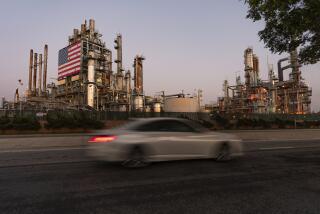Activists decry Santa Barbara oil vote coverage
- Share via
It’s been frustrating to local anti-oil activists to see such attention given to a vote by Santa Barbara County supervisors in favor of new oil drilling off the county’s coastline.
“It was distressing to see the media make this a big deal when the county board flips on this issue every few years,” said Linda Krop, chief counsel of the Santa Barbara-based Environmental Defense Center.
The Santa Barbara City Council is about to weigh in on the matter. It’s not likely to make much news. Why? Because the city has been steadfastly opposed to new offshore oil drilling since the 1969 platform blowout coated the city’s beaches with viscous goo.
The city’s resolution, scheduled for a vote today, would reiterate that “the City of Santa Barbara continues its strong support of the state and federal moratoriums on new offshore oil and gas leasing off the Santa Barbara coastline.”
The vote is likely to be unanimous, or nearly so.
What gets lost in the offshore oil debate, now playing out in this year’s presidential campaign, is that oil companies own 37 existing leases in the Santa Barbara Channel that have never been developed.
To be sure, drilling on some of these undersea tracts has been thwarted by state and federal regulatory skirmishes.
Other reasons include wild fluctuation in oil prices over the years and the fact that many major oil companies resold the leases because they were considered more trouble than they were worth -- at least compared to drilling in the Gulf of Mexico. Much of the oil off the Santa Barbara coast is thick, sour crude, more suitable for making asphalt than high-grade fuels to power jets or even high-performance SUVs.
Lack of budget stymies environmental agenda
California’s multibillion-dollar budget impasse is holding up more than funding for state agencies and programs. About 870 bills, passed by both houses of the Legislature, are in limbo, including landmark environmental legislation that would have major economic and health effects. Gov. Arnold Schwarzenegger has said he will not sign any bills until the Legislature, deadlocked in partisan conflict, can come up with a budget.
The Planning and Conservation League, a Sacramento-based nonprofit, has compiled a list of 15 top-priority bills yet to be signed by the governor.
One key initiative, the Clean Ports Investment Act, would alleviate air pollution that causes asthma and cancer in neighborhoods around the ports of Los Angeles, Long Beach and Oakland by imposing a fee on every cargo container. The $400 million a year would be used to improve infrastructure and air quality. Freight movement through the three ports generates 30% of statewide emissions of smog-forming nitrogen oxides and 75% of lung-scarring diesel particulates. However, community groups fear the governor will veto the bill, SB 974, because its author, Sen. Alan Lowenthal (D-Long Beach), has refused to amend it to spread the money around to areas far from the ports.
Another major bill, SB 375, would be the first law in the nation to control planet-heating greenhouse gases by curbing sprawl. Transportation accounts for nearly a third of the state’s carbon dioxide emissions, and reducing the amount of driving is essential if the state is to meet its goal of slashing its carbon footprint. Under the bill, sponsored by Sen. Darrell Steinberg (D-Sacramento), regional planning and transportation agencies would develop plans to reduce global warming effects. Projects that meet greenhouse gas goals would get priority for about $18 billion to $20 billion in annual transportation funds. Some environmental groups oppose the bill because it relieves the building industry from certain environmental review rules, but the governor is expected to sign it.
Another measure would require the state to identify potentially toxic chemicals in consumer products, evaluate alternatives and adopt rules to protect public health. A fourth bill would direct bond funds toward stabilizing the San Francisco Bay/Sacramento-San Joaquin Delta Estuary and increasing reliable water supplies throughout the state.
--
--
On latimes.com
Covering your world
For more, check out The Times’ environmental blog, latimesblogs.latimes.com /greenspace.
More to Read
Sign up for Essential California
The most important California stories and recommendations in your inbox every morning.
You may occasionally receive promotional content from the Los Angeles Times.











